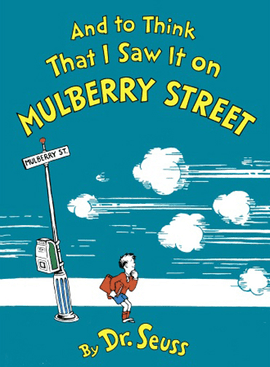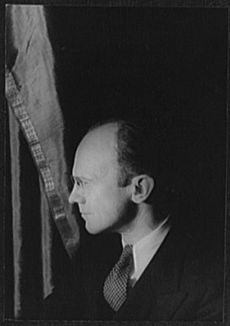And to Think That I Saw It on Mulberry Street facts for kids
 |
|
| Author | Dr. Seuss |
|---|---|
| Illustrator | Dr. Seuss |
| Cover artist | Dr. Seuss |
| Country | United States |
| Language | English |
| Genre | Children's literature |
| Published | December 21, 1937 (renewed 1964) Vanguard Press |
| Media type | Print (Hardcover), Beginner Books |
| Pages | 32 |
| OCLC | 176642 |
| Followed by | The 500 Hats of Bartholomew Cubbins |
And to Think That I Saw It on Mulberry Street is the very first children's book written and illustrated by Theodor Seuss Geisel under his famous pen name, Dr. Seuss. It was first published in 1937 by Vanguard Press. The story is about a boy named Marco. He walks home from school and imagines a super exciting parade of people and vehicles on Mulberry Street. He plans to tell his dad all about this amazing fantasy. But when he gets home, he decides to tell the simple truth: he only saw a horse and wagon.
The idea for the book came to Geisel in 1936. He was on a ship returning from a trip to Europe with his wife. The steady rhythm of the ship's engines inspired him. This rhythm led to some of the book's most famous lines:
And that is a story that no one can beat
And to think that I saw it on Mulberry Street.
Many publishers, at least 20, said no to the book at first. But then, Geisel met an old college friend who had just become an editor at Vanguard Press. Vanguard agreed to publish it! When the book came out, critics loved it, even though it didn't sell a huge number of copies right away. Later, people realized the book had ties to Geisel's own childhood. The street in the title is likely named after a real street in his hometown of Springfield, Massachusetts. Geisel used ideas from Springfield in other books too. Marco, the main character, even appeared again in another Dr. Seuss book, McElligot's Pool, in 1947. In March 2021, the people who manage Dr. Seuss's works decided to stop publishing this book because of some images. The book will become available for anyone to use in the public domain in the United States in 2033.
Contents
The Story of Marco's Imagination
The story begins with a boy named Marco walking home from school. He remembers his father's advice:
Marco, keep your eyelids up
And see what you can see.
But Marco has only seen one thing on his walk: a simple horse pulling a wagon on Mulberry Street. To make his story more exciting for his dad, Marco starts to imagine a much bigger and more detailed scene.
First, he imagines the horse is a zebra. Then, it changes into a reindeer. After that, it becomes a huge elephant! Finally, he pictures the elephant being helped by two giraffes. The wagon also changes. It becomes a fancy chariot, then a sled, and then a cart carrying a loud brass band.
Marco realizes that Mulberry Street crosses Bliss Street. This makes him imagine a group of police officers escorting the parade. The scene grows even bigger, turning into a full-blown parade! He then imagines a grandstand filled with the mayor and other important people. An airplane drops confetti from the sky. In the final, most amazing version of his imagined scene, he sees a Chinese man, a magician pulling rabbits from a hat, and a man with a super long, ten-foot beard.
Now, Marco is almost home. He snaps back to reality and rushes up the front steps. He is so excited to tell his father his incredible imagined story. However, when his father asks what he saw, Marco's face turns red. He simply says, "Nothing... but a plain horse and wagon on Mulberry Street."
How the Book Was Created
When Geisel started working on Mulberry Street, he was 33 years old. He had already spent ten years drawing cartoons, illustrating, and working in advertising. He had a successful career in advertising, including a deal with Standard Oil for their bug spray, Flit. Geisel's famous slogan was "Quick, Henry, the Flit!" He had also illustrated some books for Viking Press in 1931. These books, Boners and More Boners, were collections of funny quotes from children's school papers. These books sold well, which encouraged Geisel to try writing his own children's book. His advertising contract allowed him to do this. In 1932, Geisel wrote and drew pictures for an alphabet book with strange animals, but publishers weren't interested.
According to writers Judith and Neil Morgan, Geisel got the main idea for Mulberry Street in the summer of 1936. He was on the MS Kungsholm, a fancy Swedish American cruise ship. He was returning from a vacation in Europe with his wife, Helen Palmer. The Kungsholm went through a storm, and Geisel felt seasick. To keep busy, he started writing down a story that began with "a stupid horse and wagon." He began saying poetry to the rhythm of the ship's engines. Soon, he found himself saying, "And that is a story that no one can beat, and to think that I saw it on Mulberry Street." For days after they landed, the ship's engine rhythm was still in his head. So, Helen suggested he write a story based on it.
The Morgans learned this story from interviews with Geisel. He often told similar stories about how the book was made, sometimes changing small details. In one version, he said he had been working on the book for six months before the European trip. The trip home just gave him the final idea. In another version, he claimed the book was about half finished when they arrived back in the United States.
Geisel was a perfectionist and worked very hard on Mulberry Street. The Morgans said that even though he loved being clever, he carefully checked all his creative ideas. He spent at least six months on the book. He questioned every word and wrote many different versions. He wrote the poem in pencil on yellow paper and asked his wife to talk about every page with him.
Other Versions of the Story
A composer named Deems Taylor created an orchestral music piece based on Mulberry Street. It was called Marco Takes a Walk. The music starts with a tune for the horse and wagon. Then, it has six different musical parts that show the changes in Marco's story. The first time this music was played was at Carnegie Hall on November 14, 1942.
A short film based on the book was released by Paramount Pictures in 1944. It was made by George Pal as part of his Puppetoons series. This series had also adapted Geisel's The 500 Hats of Bartholomew Cubbins the year before. The Mulberry Street film was nominated for an Oscar for Best Short Subject (Cartoon) in 1945. Parts of this short film were shown in the 1994 TV movie In Search of Dr. Seuss.
The Book's Lasting Impact
Since Mulberry Street was Dr. Seuss's first children's book, many people see it as the starting point for all his later works. After writing a few books in regular prose (like a normal story), Geisel went back to writing in rhyme for his 1940 book, Horton Hatches the Egg. He used the same fast, rhyming style he had used in Mulberry Street. In a later series of children's stories for Redbook magazine, Geisel even shared "the latest news from Mulberry Street." In one story called "Marco Comes Late," Marco tries to explain why he is two hours late for school.
Geisel returned to fictional versions of his hometown in three later books. These books, along with Mulberry Street, are sometimes called the Springfield Cycle. McElligot's Pool (1947), If I Ran the Zoo (1950), and If I Ran the Circus (1956) all take place in different made-up versions of Springfield. Each of these books also features a young main character. When an adult asks them a question, they respond with "a series of increasingly fantastic scenarios." McElligot's Pool also brings Marco back as a main character in a Dr. Seuss book.
In 1986, Geisel visited Springfield as part of a book tour. Dozens of children greeted him on Mulberry Street. Another group of children held up a banner that said, "And to think that we saw him on Mulberry Street." John Fogerty, the lead singer for the band Creedence Clearwater Revival, has said that the band's song "Lookin' Out My Back Door" was partly inspired by the book.
In 1961, the book received the Lewis Carroll Shelf Award, which is a special honor.
Book Withdrawal
Dr. Seuss Enterprises decided to stop publishing Mulberry Street in March 2021. They also stopped publishing five other books by Seuss. This decision was made because some of the images in these books were seen as "hurtful and wrong." While Dr. Seuss Enterprises did not say exactly which pictures were problematic, some news reports pointed to a drawing in Mulberry Street of a "Chinese man." This character was shown with slanted lines for eyes, a conical hat, and clog shoes. He was also carrying chopsticks to eat a bowl of rice. In the original book, this character was called a "Chinaman" and had a long braid of hair (a queue) and yellow skin. Dr. Seuss changed these features in the 1970s when the character's name was changed to "a Chinese man." Other images that might have been reasons for the withdrawal include drawings of a "Rajah, with rubies" and two fur-clad figures being pulled by a reindeer.
Removing these books from publication caused a big increase in sales for other Dr. Seuss books. Many of his other books quickly became bestsellers on Amazon in the United States. It was reported that nine of the top ten bestselling books were all by Dr. Seuss, not including the ones that were removed. The value of Mulberry Street for collectors also went up a lot. Cash offers for the book rose on eBay before those listings were removed for having "offensive content."
See also
 In Spanish: Y pensar que lo vi en la calle Porvenir para niños
In Spanish: Y pensar que lo vi en la calle Porvenir para niños


